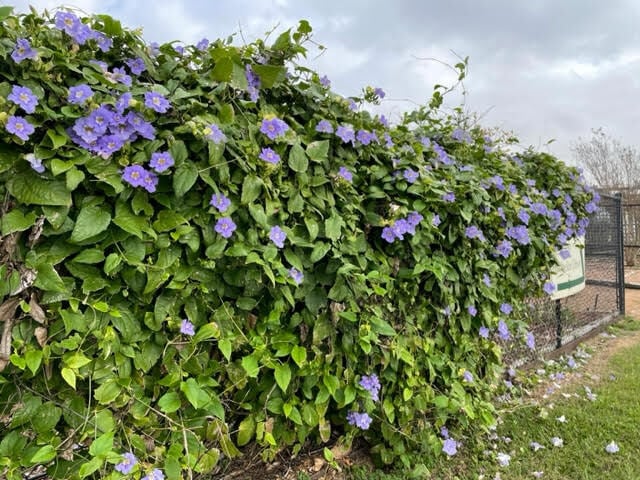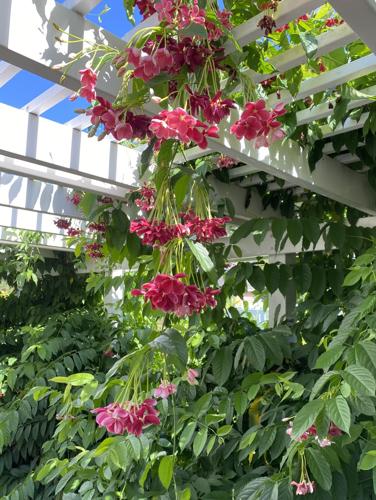The Vines of the VEG: Know the vines’ habits before planting
By Brenda Heinold – Victoria Master Gardener

PHOTO CONTRIBUTED BY BRENDA HEINOLD/VICTORIA COUNTY MASTER GARDENER – The ‘Tangerine Beauty’ Crossvine between the Victoria Educational Gardens Children’s Garden and entrance to VEGGIE & Butterfly Haven Area.

PHOTO CONTRIBUTED BY BRENDA HEINOLD/VICTORIA COUNTY MASTER GARDENER – Evergreen Wisteria provides a shady roof when supported by a sturdy arbor.

PHOTO CONTRIBUTED BY VICTORIA COUNTY MASTER GARDENER BRENDA HEINOLD – This Skyflower vine, growing on a chainlink fence, blooms on both sides.

PHOTO CONTRIBUTED BY VICTORIA COUNTY MASTER GARDENER BRENDA HEINOLD – Rangoon Creeper grows up the corner column of a large arbor. If left untrimmed, it will easily cover the top as well.

PHOTO CONTRIBUTED BY PAT PLOWMAN/VICTORIA COUNTY MASTER GARDENER – Rangoon Creeper growing at a master gardeners’ home. Note how beautiful the blooms are as they hang from the arbor.
Vines add dramatic interest to a garden. They can create a backdrop or enclosure to showcase other garden elements, provide wind protection, or grow into a leafy roof to shade both plants and people. And they can do all this while also giving us colorful blooms.
Perhaps nothing is more difficult for a gardener than selecting the right vine for the right use. I have purchased and planted several vines in my yard, only to watch them outgrow their trellises. I have underestimated how much room a vine needs and have watched them smother surrounding plants.
To prevent disappointment, the wise gardener will observe vines in their mature size and will note their growth patterns, supporting structures, and maintenance requirements. The Victoria Educational Gardens, nicknamed “The VEG” is an excellent place to see mature vines and how they work in the landscape.
Although The VEG contains many smaller vines, this article is limited to the large vines that require sturdier supports.
YELLOW BUTTERFLY VINE
Yellow butterfly vine (Callaeum macropterum) is a Texas Superstar that grows well on a fence or trellis. It bears clusters of yellow flowers from spring through fall, followed by butterfly-shaped seed pods.
Yellow butterfly vine grows 10-15 feet tall in full or partial sun and requires a sturdy support such as fence or trellis. It is an aggressive grower, so it is best not to plant it within 10 feet or so of surrounding shrubs or trees.
EVERGREEN WISTERIA
Evergreen wisteria (Millettia reticulata), also known as summer wisteria, is a vigorous grower that needs a sturdy support. It has small purple-red flowers in summer and glossy, leathery green leaves. The top-heavy vine is great for large arbors and can shelter a patio completely, as can be seen on the east side of the VEG. This plant is not for a light-weight trellis.
RANGOON CREEPER
Another vine that requires a sturdy support is the rangoon creeper (Combretum indicum). It can grow 25-30 feet. It is drought-tolerant and deer-resistant. Clusters of fragrant, tubular flowers in white, pink and red attract moths, hummingbirds and butterflies. Rangoon creeper benefits from annual pruning to keep its vigorous growth in check.
BLUE SKY VINE
Blue sky vine (Thunbergia grandiflora) grows up to 12 feet and is not as top-heavy as many of the other vines listed. Its dense leaves that create a good wind barrier growing on a chain-link fence at the VEG. Although it can freeze to the ground, it readily resprouts from the roots. Removing old branches before spring growth helps maintain a neat appearance.
TANGERINE BEAUTY CROSSVINE
‘Tangerine Beauty’ Crossvine (Bignonia capreolata) grows on an arbor near the Butterfly Haven at the VEG. Because it can be top-heavy, it does well on an arbor that provides horizontal support. In late winter, it will be covered in masses of tangerine flowers.
PASSIONFLOWER
Passionflower (Passiflora spp) grows in the VEG on an arched arbor created from cattle panels and posts. This vine spread from the Butterfly Haven, so the gardener will need to watch for and remove unwanted plants in a wide area around the vine. Our passionflower is an unknown variety and produced lots of fruit that does not appear to be edible.
Visit the VEG often throughout the year. Take notes of the vines at different times of the year. Snap pictures of the support structures and talk to the Master Gardeners about the maintenance required for each vine.
We have many vining plants in addition to those listed above. With a little diligence, you will find the right one for you.
The Gardeners’ Dirt is written by members of the Victoria County Master Gardener Association, an educational outreach of Texas A&M AgriLife Extension – Victoria County. Mail your questions in care of the Advocate, P.O. Box 1518, Victoria, TX 77901; or [email protected], or comment on this column at VictoriaAdvocate.com.
References
//Aggie-hort.tamu.edu
//south-florida-plant-guide.com
//davesgarden.com